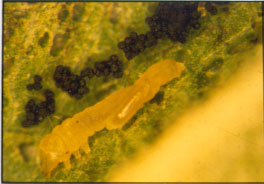Tentiform Leafminer Parasite
General Description
This parasite is so effective against the tentiform leafminer that chemical controls are usually not needed. Fall surveys in the Okanagan revealed over 95% parasitism of leafminer larvae.
Hosts
Tentiform leafminer larvae.
The wasp kills by feeding on and stinging leafminer larvae. It usually takes 1-2 years after the first appearance of the leafminer before the parasites effectively control the pest. Thirty percent parasitism of the first-generation tissue-feeder larvae in the spring should provide biological control for the rest of the season.
Damage
Identification
Egg - white, cylindrical, laid inside leafminer mine.
Larva - maggot-like, spindle-shaped, white to cream coloured, mature larva size 1.5 mm. It feeds outside the body of the host, easily seen with a hand lens (Fig. 1).

Figure 1. Tentiform leafminer parasite larva feeding on leafminer larva. (BCMA)
Adult - wasp-like, dark colored thorax with a blue metallic sheen, yellow and black abdomen, size 1.5 – 2.5 mm, male has branched antennae.
Life History
Overwinter primarily as pupae in mines of leaves on orchard floor. Adults emerge in the spring about the same time as the leafminer. There are at least three generations per year. All stages except adult wasps are found within leaf mines.
Monitoring
Examine the tent-shaped mines of the tentiform leafminer within apple leaves for parasite larvae or pupae. For each generation, parasitism levels of 35% or more is sufficient to keep leafminers under control. If parasitism levels are below 20% then there might be a need for chemical control. To improve biological control of leafminers, avoid using chemicals when adult parasites are active (around the same time leafminer adults are active). Improper timing of certain insecticides will disrupt leafminer biological control.
